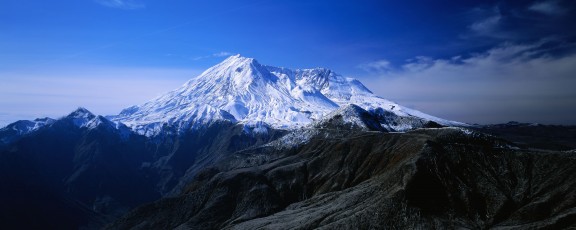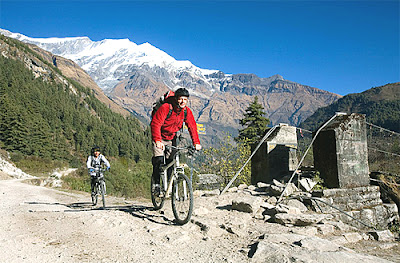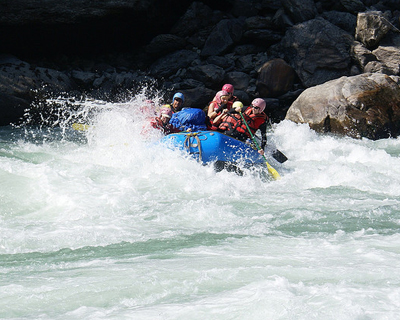Rafting is inarguably the simplest manner of exploring Arcadian Nepal. The waters supply one thing to everybody: from grade 5-5+ rivers with several raging Whitewater Rafting for the brave and therefore the adventurous, to grade 2-3 rivers with a number of rapids for the laid-back sort. the gorgeous issue is that almost about anybody, whether or not recent or terribly young, can raft. Moreover, it will either be a two-week trip or a 2-3 day trip-you decide.
RAFTING Kayaking Canyoning the very fact that you simply wish to raft down Nepal's difficult rivers means you've got some time past graduated from the nursery faculty of "Row, row, row your boat". the various 'raftable' rivers in Nepal meander between canyons, villages, and forests, wildlife, like pine needle through thread, weaving the country's wealthy tapestry of ethno-culture and bio-diversity. Originating within the bowels of the himalaya, these rivers flow across the length and breadth of Nepal and neighboring India, before emptying largely into the Bay of Bengal.
Paddle rafting is strongly suggested. It involves teamwork with the river runner barking directions from his perch on the aft. you'll be able to either do participatory rafting, where you and your cluster are given a runner and barebone workers support, or a "luxury safari style" trip where a full team of workers is provided to handle your group's each want and wish. Mind you, rafting isn't the sole thanks to travel downstream. a number of firms provide inflatable kayaks, or fiberglass kayaks for rent.
An extreme sport popular in Europe, Canoeing is now available in Nepal. Canoeing gives you the freedom to explore some of the most ruggedly beautiful, yet forbidden places in the world.
Season
October through mid-December and March through early might are the most effective times. it's doable in winter, however you've got to look at out for hypothermia. Throughout monsoon (June through September), the whitewater sections are dangerous, however gentler stretches are runnable.
Raft Route
River Profiles: up to now the govt. has opened sections of ten rivers for industrial rafting.
Karnali (arcade 4-5): Nepal's longest, it flows through steep, jagged canyons where the rapids are tightly-packed, giving continuous difficult water in the slightest degree flows. Either a bus ride to far-western Nepal or a flight to Nepalgunj will take you there. The river section takes concerning seven days to navigate, at the same time as you explore canyons and waterfalls. For those craving an adrenaline rush, this river could be a should.
Sun Kosi (grade 4-5): this is often the longest river trip (270km) offered in Nepal. you start at Dolalghat simply 3 hours out of Katmandu and finish in Chatara, down the Gangetic Plain of north India, nine or ten days later. The Sun Kosi starts off with comparatively delicate rapids the primary number of days. The surprises sneak up on you throughout the last days. it's thought of one in all the world's prime ten classic river journeys.
Trisuli (grade 3+): the most affordable river trip offered in Nepal, where you pay $20 or thus per day. though comparatively unsafe throughout monsoon, it's fun otherwise. A Trisuli river trip may be combined with visits to Chitwan or Pokhara. it's undoubtedly the foremost well-liked of Nepal's raftable rivers.
Kali Gandaki (grade 5-5+): Sacred Hindu river, here the rapids are technically difficult, winding through canyons and gorges. beginning at Baglung, you may raft right down to Ramdighat in five-six days. you will then continue on to the confluence with the Trisuli at Devghat, adding another a hundred thirty km and 3-4 days.
Bhote Kosi (grade 4-5): some of hours out of Kathmandu, it's twenty six km of continuous white water. may be tired two days. it's the steepest river rafted in Nepal, requiring Zen-like concentration from the river-runner, and giving an adrenaline rush even in low-water months. beginning higher than Barabise, you raft right down to the dam at Lamosangu.
Upper Sun Kosi (grade 1-2): Begins at Khadichour and ends in Dolalghat. The river is lined with clean sandy beaches, that build for nice picnic or camping spots. The trip offers a good family getaway, removed from the madding crowd.
Marsyangdi (grade 5-5+): The raging Marsyangdi is four days of continuous white water. Begins from the village of Ngadi, up from Besisahar. because the rapids are unrelenting, it's suggested that you simply consult corporations with variant expertise on underneath their belt. For individuals yearning for a 5-6 tour with raging rapids, the Marsyangdi is unquestionably where it's at.
Other rivers: The Bheri in western Nepal may be combined with a visit to the Royal Bardia National park. The Arun from Tumlingtar is another choice.
Safety
Safety is the most important part of any river trip. Choosing a professional veteran rafting company is the first step. So it helps to abide by the following tips:
Pick your river with care. Seek information from a rafting agency, local experts, and literature on river levels and difficulty.
There should be a minimum of two rafts per trip, so that one can help when a fall happens from the other.
Carry first-aid kit, survival and rescue gear.
Check to see that end loops and the leash are adequate before you push off. This makes it easier to keep hold of your boat when swimming big rapids, and also in the event of rescue.
Be a team person, paddle synchronously.
For boats, paddles and helmets, loud colors are recommended.
Wear life jackets and helmets, properly too.
Keep your feet and arms inside the raft at all time.
When you fall off into a rapid, float on your back, with your feet downstream.
RAFTING Kayaking Canyoning the very fact that you simply wish to raft down Nepal's difficult rivers means you've got some time past graduated from the nursery faculty of "Row, row, row your boat". the various 'raftable' rivers in Nepal meander between canyons, villages, and forests, wildlife, like pine needle through thread, weaving the country's wealthy tapestry of ethno-culture and bio-diversity. Originating within the bowels of the himalaya, these rivers flow across the length and breadth of Nepal and neighboring India, before emptying largely into the Bay of Bengal.
Paddle rafting is strongly suggested. It involves teamwork with the river runner barking directions from his perch on the aft. you'll be able to either do participatory rafting, where you and your cluster are given a runner and barebone workers support, or a "luxury safari style" trip where a full team of workers is provided to handle your group's each want and wish. Mind you, rafting isn't the sole thanks to travel downstream. a number of firms provide inflatable kayaks, or fiberglass kayaks for rent.
An extreme sport popular in Europe, Canoeing is now available in Nepal. Canoeing gives you the freedom to explore some of the most ruggedly beautiful, yet forbidden places in the world.
Season
October through mid-December and March through early might are the most effective times. it's doable in winter, however you've got to look at out for hypothermia. Throughout monsoon (June through September), the whitewater sections are dangerous, however gentler stretches are runnable.
Raft Route
River Profiles: up to now the govt. has opened sections of ten rivers for industrial rafting.
Karnali (arcade 4-5): Nepal's longest, it flows through steep, jagged canyons where the rapids are tightly-packed, giving continuous difficult water in the slightest degree flows. Either a bus ride to far-western Nepal or a flight to Nepalgunj will take you there. The river section takes concerning seven days to navigate, at the same time as you explore canyons and waterfalls. For those craving an adrenaline rush, this river could be a should.
Sun Kosi (grade 4-5): this is often the longest river trip (270km) offered in Nepal. you start at Dolalghat simply 3 hours out of Katmandu and finish in Chatara, down the Gangetic Plain of north India, nine or ten days later. The Sun Kosi starts off with comparatively delicate rapids the primary number of days. The surprises sneak up on you throughout the last days. it's thought of one in all the world's prime ten classic river journeys.
Trisuli (grade 3+): the most affordable river trip offered in Nepal, where you pay $20 or thus per day. though comparatively unsafe throughout monsoon, it's fun otherwise. A Trisuli river trip may be combined with visits to Chitwan or Pokhara. it's undoubtedly the foremost well-liked of Nepal's raftable rivers.
Kali Gandaki (grade 5-5+): Sacred Hindu river, here the rapids are technically difficult, winding through canyons and gorges. beginning at Baglung, you may raft right down to Ramdighat in five-six days. you will then continue on to the confluence with the Trisuli at Devghat, adding another a hundred thirty km and 3-4 days.
Bhote Kosi (grade 4-5): some of hours out of Kathmandu, it's twenty six km of continuous white water. may be tired two days. it's the steepest river rafted in Nepal, requiring Zen-like concentration from the river-runner, and giving an adrenaline rush even in low-water months. beginning higher than Barabise, you raft right down to the dam at Lamosangu.
Upper Sun Kosi (grade 1-2): Begins at Khadichour and ends in Dolalghat. The river is lined with clean sandy beaches, that build for nice picnic or camping spots. The trip offers a good family getaway, removed from the madding crowd.
Marsyangdi (grade 5-5+): The raging Marsyangdi is four days of continuous white water. Begins from the village of Ngadi, up from Besisahar. because the rapids are unrelenting, it's suggested that you simply consult corporations with variant expertise on underneath their belt. For individuals yearning for a 5-6 tour with raging rapids, the Marsyangdi is unquestionably where it's at.
Other rivers: The Bheri in western Nepal may be combined with a visit to the Royal Bardia National park. The Arun from Tumlingtar is another choice.
Safety
Safety is the most important part of any river trip. Choosing a professional veteran rafting company is the first step. So it helps to abide by the following tips:
Pick your river with care. Seek information from a rafting agency, local experts, and literature on river levels and difficulty.
There should be a minimum of two rafts per trip, so that one can help when a fall happens from the other.
Carry first-aid kit, survival and rescue gear.
Check to see that end loops and the leash are adequate before you push off. This makes it easier to keep hold of your boat when swimming big rapids, and also in the event of rescue.
Be a team person, paddle synchronously.
For boats, paddles and helmets, loud colors are recommended.
Wear life jackets and helmets, properly too.
Keep your feet and arms inside the raft at all time.
When you fall off into a rapid, float on your back, with your feet downstream.




















